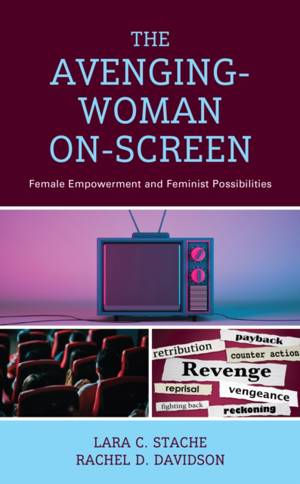
- Afhalen na 1 uur in een winkel met voorraad
- Gratis thuislevering in België vanaf € 30
- Ruim aanbod met 7 miljoen producten
- Afhalen na 1 uur in een winkel met voorraad
- Gratis thuislevering in België vanaf € 30
- Ruim aanbod met 7 miljoen producten
Zoeken
The Avenging-Woman On-Screen
Female Empowerment and Feminist Possibilities
Lara C Stache, Rachel D Davidson
Hardcover | Engels
€ 145,45
+ 290 punten
Omschrijving
In The Avenging-Woman On-Screen: Female Empowerment and Feminist Possibilities, Lara C. Stache and Rachel D. Davidson demonstrate how the on-screen character of the avenging-woman offers a complex construction of femininity that serves as a representation of cultural conversations about female empowerment, female agency, and feminism. This character is both woman and hero, typically both physically appealing and physical aggressive--a dichotomy that goes against traditional gendered norms of femininity. Television and film narratives produced since 2010, the authors posit, offer an opportunity to reflect on and consider the evolution of cultural ideologies about women and power, given the significant cultural shifts in Hollywood that occurred amid the #MeToo explosion and post-Harvey Weinstein revelations. Stache and Davidson argue that depictions of the avenging-woman utilize a feminist language of empowerment that suggests the potential for a subversive message against the patriarchy while also recognizing that an alternative reading of some representations presents, at times, a hegemonic construction of empowerment that ultimately cautions against subversion within patriarchal systems. The authors question how these representations may limit social change or, in some cases, represent particularly progressive rhetorics about women and power. Scholars of communication, media studies, film and television studies, and women's studies will find this book of particular interest.
Specificaties
Betrokkenen
- Auteur(s):
- Uitgeverij:
Inhoud
- Aantal bladzijden:
- 206
- Taal:
- Engels
Eigenschappen
- Productcode (EAN):
- 9781666915556
- Verschijningsdatum:
- 10/10/2023
- Uitvoering:
- Hardcover
- Formaat:
- Genaaid
- Afmetingen:
- 152 mm x 229 mm
- Gewicht:
- 471 g

Alleen bij Standaard Boekhandel
+ 290 punten op je klantenkaart van Standaard Boekhandel
Beoordelingen
We publiceren alleen reviews die voldoen aan de voorwaarden voor reviews. Bekijk onze voorwaarden voor reviews.











